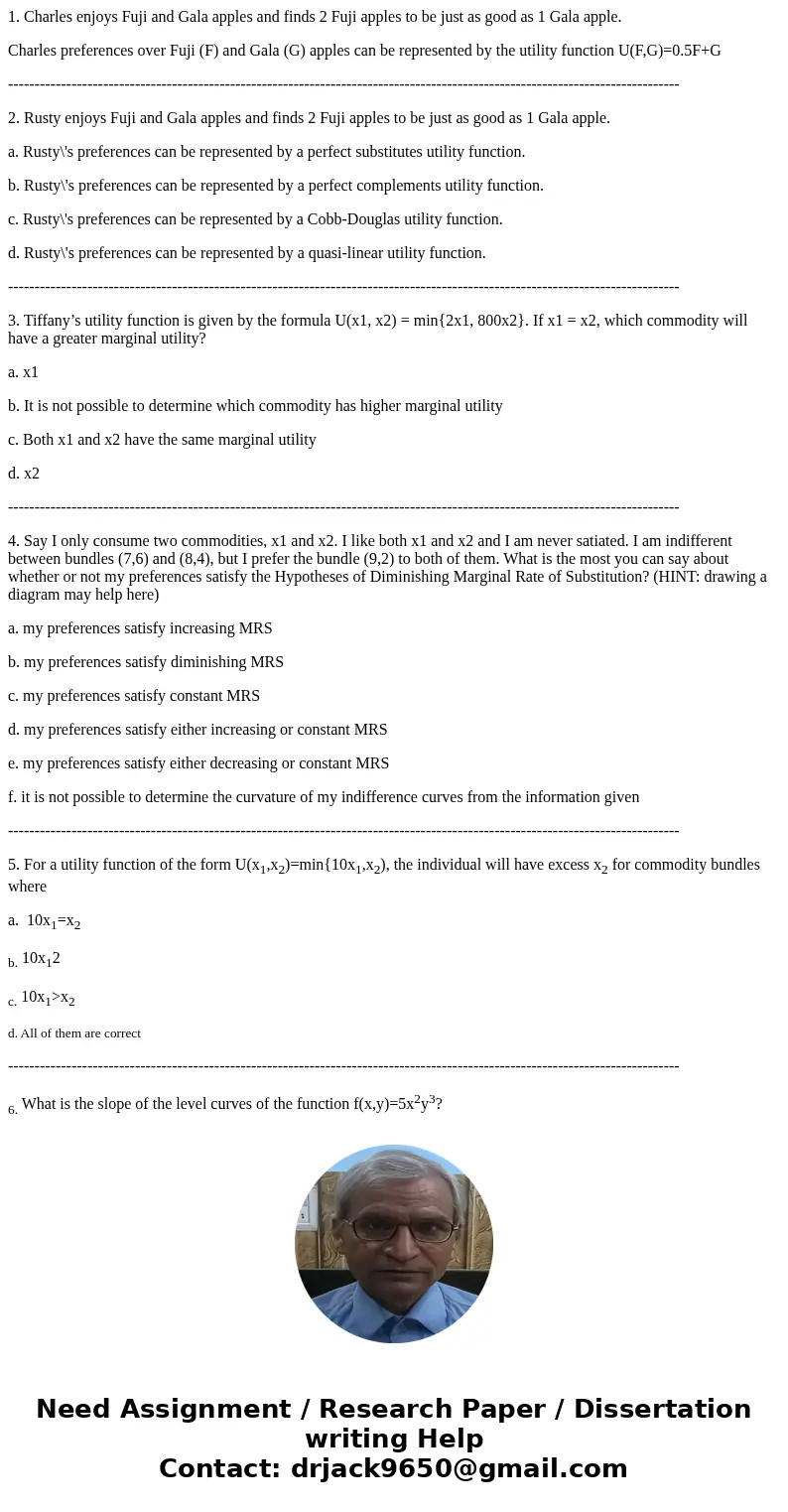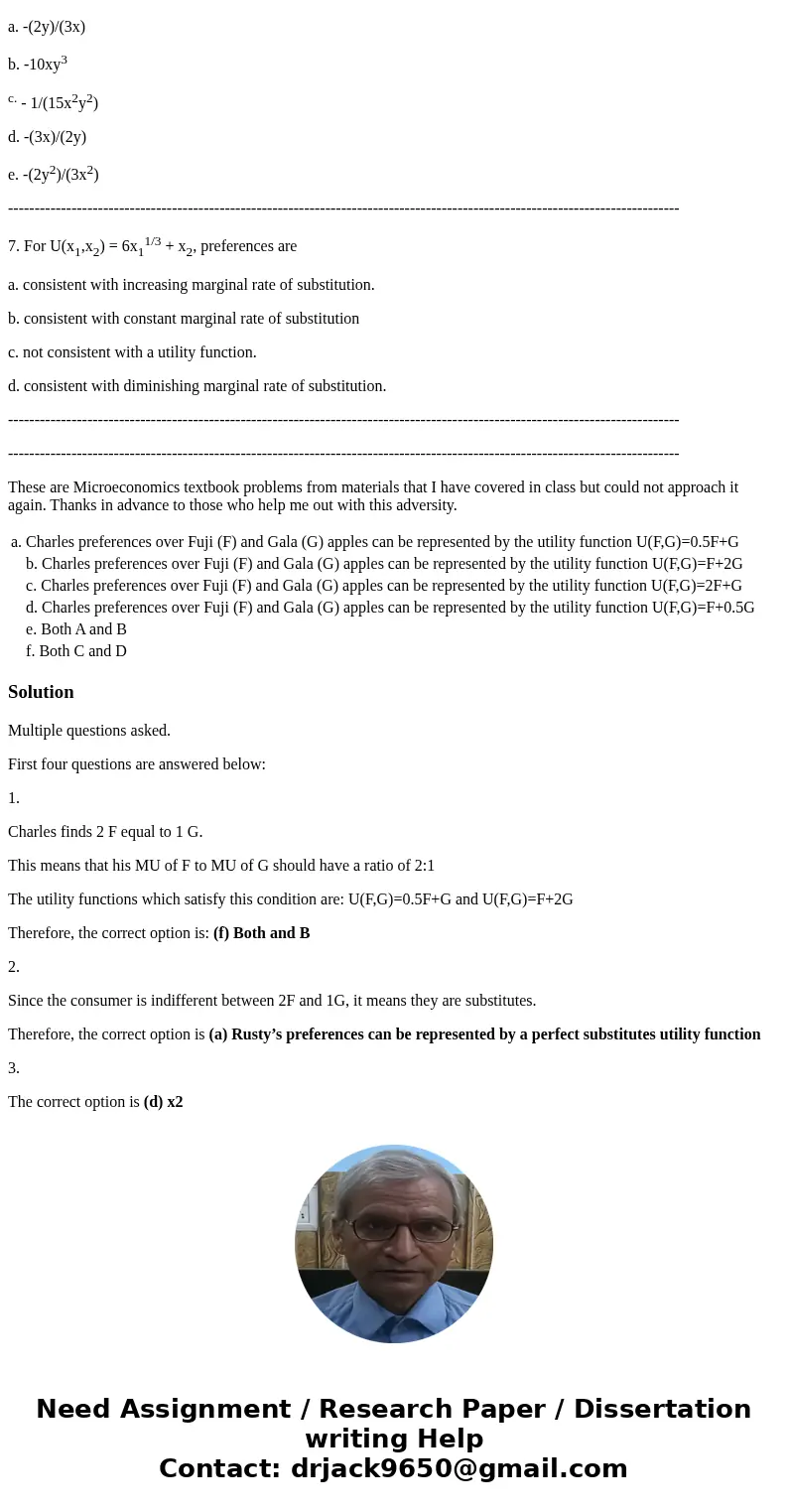1 Charles enjoys Fuji and Gala apples and finds 2 Fuji apple
1. Charles enjoys Fuji and Gala apples and finds 2 Fuji apples to be just as good as 1 Gala apple.
Charles preferences over Fuji (F) and Gala (G) apples can be represented by the utility function U(F,G)=0.5F+G
-------------------------------------------------------------------------------------------------------------------------------
2. Rusty enjoys Fuji and Gala apples and finds 2 Fuji apples to be just as good as 1 Gala apple.
a. Rusty\'s preferences can be represented by a perfect substitutes utility function.
b. Rusty\'s preferences can be represented by a perfect complements utility function.
c. Rusty\'s preferences can be represented by a Cobb-Douglas utility function.
d. Rusty\'s preferences can be represented by a quasi-linear utility function.
-------------------------------------------------------------------------------------------------------------------------------
3. Tiffany’s utility function is given by the formula U(x1, x2) = min{2x1, 800x2}. If x1 = x2, which commodity will have a greater marginal utility?
a. x1
b. It is not possible to determine which commodity has higher marginal utility
c. Both x1 and x2 have the same marginal utility
d. x2
-------------------------------------------------------------------------------------------------------------------------------
4. Say I only consume two commodities, x1 and x2. I like both x1 and x2 and I am never satiated. I am indifferent between bundles (7,6) and (8,4), but I prefer the bundle (9,2) to both of them. What is the most you can say about whether or not my preferences satisfy the Hypotheses of Diminishing Marginal Rate of Substitution? (HINT: drawing a diagram may help here)
a. my preferences satisfy increasing MRS
b. my preferences satisfy diminishing MRS
c. my preferences satisfy constant MRS
d. my preferences satisfy either increasing or constant MRS
e. my preferences satisfy either decreasing or constant MRS
f. it is not possible to determine the curvature of my indifference curves from the information given
-------------------------------------------------------------------------------------------------------------------------------
5. For a utility function of the form U(x1,x2)=min{10x1,x2), the individual will have excess x2 for commodity bundles where
a. 10x1=x2
b. 10x12
c. 10x1>x2
d. All of them are correct
-------------------------------------------------------------------------------------------------------------------------------
6. What is the slope of the level curves of the function f(x,y)=5x2y3?
a. -(2y)/(3x)
b. -10xy3
c. - 1/(15x2y2)
d. -(3x)/(2y)
e. -(2y2)/(3x2)
-------------------------------------------------------------------------------------------------------------------------------
7. For U(x1,x2) = 6x11/3 + x2, preferences are
a. consistent with increasing marginal rate of substitution.
b. consistent with constant marginal rate of substitution
c. not consistent with a utility function.
d. consistent with diminishing marginal rate of substitution.
-------------------------------------------------------------------------------------------------------------------------------
-------------------------------------------------------------------------------------------------------------------------------
These are Microeconomics textbook problems from materials that I have covered in class but could not approach it again. Thanks in advance to those who help me out with this adversity.
| a. | Charles preferences over Fuji (F) and Gala (G) apples can be represented by the utility function U(F,G)=0.5F+G | |
| b. Charles preferences over Fuji (F) and Gala (G) apples can be represented by the utility function U(F,G)=F+2G | ||
| c. Charles preferences over Fuji (F) and Gala (G) apples can be represented by the utility function U(F,G)=2F+G | ||
| d. Charles preferences over Fuji (F) and Gala (G) apples can be represented by the utility function U(F,G)=F+0.5G | ||
| e. Both A and B | ||
| f. Both C and D |
Solution
Multiple questions asked.
First four questions are answered below:
1.
Charles finds 2 F equal to 1 G.
This means that his MU of F to MU of G should have a ratio of 2:1
The utility functions which satisfy this condition are: U(F,G)=0.5F+G and U(F,G)=F+2G
Therefore, the correct option is: (f) Both and B
2.
Since the consumer is indifferent between 2F and 1G, it means they are substitutes.
Therefore, the correct option is (a) Rusty’s preferences can be represented by a perfect substitutes utility function
3.
The correct option is (d) x2
4.
Since the goods are preferred in the ratio such that gaining one unit of x1 involves loosing 2 more units of x2. This satisfies the diminishing MRS Law.
Therefore, the correct option is (b) my preferences satisfy diminishing MRS



 Homework Sourse
Homework Sourse